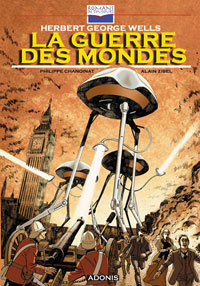|
|
Tweet | Follow @warworlder |
 |
 |
 |
|||||||||||||||||||||||
|
|
War of the Worlds comics, part 3In 1996, Arrow Comics (under the Caliber Comics banner) produced their series The War of the Worlds: The Haven and the Hellweed, a particularly good story that pitches the reader straight into a modern day battle between the Martians and an embattled resistance. This is a complete reinvention of the story, but retains (and updates) all the iconic imagery of the original novel to strong effect. A second series from Arrow Comics was begun in 1998, called The Memphis Front, but regretfully the intended 5 part run came to an abortive end after only 2 issues. 1998 saw the triumphant return (yet again) of Roy Thomas (clearly a huge fan) to The War of the Worlds universe in the DC Elseworlds series, which in a single issue pitted Superman against the Martians in a stunning tale set in the year 1938. It stands as one of the very best comic books ever written about The War of the Worlds, and as befits the time it is set in, works in plenty of sly references to the Orson Welles broadcast. There have been a number of other attempts to re-imagine the War of the Worlds in new and novel ways. One of the most intriguing must be The League of Extraordinary Gentlemen (1999), a splendid reinvention of the story from writer Alan Moore and artist Kevin O'Neill that mingles a veritable who's who of fictional characters including Jules Vernes' Captain Nemo, Wells' Invisible Man and Rider Haggard's Allan Quartermain. In the second volume of their adventures, the team of adventurers go up against a Martian invasion that rewrites the original Wells novel in supremely bloodthirsty fashion. Also in a similar vein to The League of Extraordinary Gentlemen, writer Ian Edginton and artist D'Israeli have provided their own audacious spin on the original story. Scarlet Traces (2003) is a well thought out steampunk sequel to The War of the Worlds, which postulates what might have happened to all that abandoned Martian hardware. An equally well-produced sequel, The Great Game (2006), sees a resurgent British Empire launch a counter-invasion to the red planet. With the release of the 2005 Steven Spielberg version of The War of the Worlds, some old (and new) comics saw the light of day. The original Classics Illustrated comic was re-issued, but best of all fans were treated to a number of new adaptations. Best Sellers Illustrated came up with an interesting retelling of the story that makes a reasonable attempt to fit a Martian invasion into modern times, while from IIDW Publishing (under their Little Book of Horror banner) came an extensively abridged and rewritten treatment of the original story, which nonetheless boasted some stunning illustrations. However, it was Dark Horse Comics who in 2006 stole the show, re-uniting the team behind Scarlet Traces for a very faithful adaptation of the original novel. Eureka Productions have published two collections of science fiction stories of interest to War of the Worlds fans. Graphic Classics: H.G. Wells (2005) features an interesting (if slightly inaccurate) retelling of events during the 1938 Orson Welles radio broadcast while Science Fiction Classics adapts The War of the Worlds itself along with several other excellent science fiction tales including Stanley Weinbaum's A Martian Odyssey. The always intriguing possibility of a 2nd Martian invasion fuelled a new take on the story from Boom comics in 2006. Their War of the Worlds: Second Wave is similar in style to the Steven Spielberg movie, with an everyday average Joe character caught up in the insanity of an alien invasion. The art by the enigmatically named Chee is of a high standard, with the opening colour spread of the first issue proving particularly effective. For those seeking a more traditional but certainly different take on the story, French publisher Adonis produced a lovely retelling of La Guerre des Mondes in 2007, featuring some stylish art and a lot of very nice background material. Published in 2010 and taking an entirely black and white approach is The Broadcast, a stylish retelling of the 1938 broadcast from the point of view of the embattled residents of a small American town not unlike Grover's Mill. In 2011 and 2011, the two premier teams in the Marvel Comics universe featured guest appearances from that stalwart Martian hunter, Killraven. Neither were particularly satisfying, with Guardians of the Galaxy perhaps outshining The Avengers, but both featured highly imaginative visions of the Martian Tripods. Another comic book series that has gone out of its way to present amazing illustrations of Martian Tripods is the American magazine Heavy Metal. In promotion of the forthcoming animated movie War of the Worlds Goliath, the magazine has published a number of issues with stories set in the same world as the movie, a post invasion earth much changed by left over Martian technology and now facing a 2nd even bigger invasion. 2011 saw 3 issues published, Heavy Metal January 2011, Heavy Metal July 2011 and a Heavy Metal Summer Special 2011, the latter of which was completely given over to The War of the Worlds. Graphic novels like The Broadcast set the bar high, but there is still more to come. A new comic book that blends the Martian adventurer Lt. Gulliver Jones with the Mars of H.G Wells is on the way. Writer Mark Ellis and artist Preston Asevedo look to be on to a winner with this intriguing mash up. Gulliver Jones is the original Martian hero, predating the more famous John Carter by a number of years. In bringing the two books together, Ellis is imagining a post invasion earth traumatised by the Martian onslaught, a situation he postulates would, "make the fear the US experienced in the wake of 9/ll seem like concern over a hangnail." Jones is back on earth when we rejoin him, a hero of the war against the Martians, and now ready to take command of a new space vessel based on Martian technology that has been reverse engineered by none other than Nikola Tesla. Nice to see Tesla get a shot at taking on the Martians, as his great rival Thomas Edison had a similar opportunity in the 1898 newspaper serial Edison's Conquest Of Mars. Early indications are that this will be something to look forward, though if this short history proves nothing else, this surely won't be the last time we'll see The War of the Worlds return to the comic book world. < Part 2 |
Reviews
|
|||||||||||||||||||||||
home - books - comics - film - gallery - links - mars - music - news - radio - shop - timeline
about - advertise - contact - privacy



















